Planning your own trip? Prepare for your trip
Use Rough Guides' trusted partners for great rates
Book your individual trip, stress-free with local travel experts
Not sure where to travel in July? You’re in the right place. From classic beach breaks in Europe (with added culture) and bucket-list safaris in Tanzania, to Trinidadian turtle-watching trips and Alaskan adventures, read on to discover the best places to travel in July, along with suggestions for where to stay.

Sopot, Poland — one of the best places to travel in July for seaside sophistication © Shutterstock
Why visit: seaside sophistication
Temperature: 59°F to 73°F (15°C to 23°C)
Average daily budget: $80-$120
Lying 9.32 miles (15km) northwest of Gdańsk in northern Poland, it's easy to see why Sopot is known as the Polish riviera.
Back in its 1920s and 1930s heyday, Sopot lured the rich and famous to its casinos, shops and spas. And today this pretty Polish resort town retains an air of Riviera sophistication, with Europe’s longest wooden pier, and an expanse of golden sand.
In place of tacky souvenir stalls, the pier boasts simple, elegant cafés — perfect for people-watching.
The same applies to Sopot’s main street, Monte Cassino. This attractive, pedestrianized thoroughfare melds old time charm with the contemporary quirks of its Crooked House.
Planning a longer trip? Find out why you should travel around Poland by train.
Where to stay: for five-star style, historic stunner Sofitel Grand boasts a private beach.
Traveling as a family? Hotel Sopot is pet-friendly, near a beach and boasts a playground.

Wellington, New Zealand © Shutterstock
Why visit: food, festivals and forest walks
Temperature: 43°F to 54°F (6°C to 12°C)
Average daily budget: $120-$220
The main departure point for New Zealand's South Island, Wellington is a great place to enjoy café culture, arts culture and top nightlife.
This ramps up during July and August, when the city hosts a few fabulous festivals, among them Sounds in the Square and Family Fun in the Bowring.
Wellington is also New Zealand’s culinary capital, with a cracking craft beer scene and renowned regional wines.
And in good news for those wanting to explore the great outdoors, Wellington’s surrounding wooded Town Belt offers excellent walks.
Want to explore more of New Zealand? Check out our customizable New Zealand itineraries.
Where to stay: like the sound of home comforts in a 100-year-old historic villa? Head to Terrace Villas Apartments.
On a budget? Hotel Waterloo & Backpackers offers affordable dorms and rooms in a former fancy hotel.

Shanklin Beach, Isle of Wight © Dinko G Kyuchukov/Shutterstock
Why visit: relaxation, family fun and scenic walks
Temperature: 57°F to 72°F (14°C to 22°C)
Average daily budget: $120-$200
Loaded with traditional tea rooms, romantic gardens, and cozy pubs with cute gardens, the Isle of Wight is the ideal UK vacation destination if you want to take it easy.
That said, being chock-full of dinosaur fossils, seaside resorts and beaches, it’s not half bad on the child-pleasing front, either. Families with monster-mad kids will want to walk across Compton Bay at low-tide to see dinosaur footprints appear.
Love exploring the great outdoors? With over half the island a designated Area of Outstanding Natural Beauty — and one of only seven UK sites to have UNESCO Biosphere Reserve status — it’s no surprise that walking on the wilder side is another of the island’s top experiences.
For example, one of the Isle of Wight’s most scenic walks stretches seven miles between Tennyson Down and the iconic white chalk stacks of the Needles Headland.
Editor’s tip: be sure to visit Shanklin — one of Britain’s best seaside towns, and get yourself a copy of British Breaks Isle of Wight.
Where to stay: Shanklin’s elegant Aqua Hotel juts out of the cliffside, faces the sea, and boasts its own brasserie.
Travelling as a family? Try Wight Bay Hotel in Sandown.

Alhambra, Granada © Shutterstock
Why visit: fiery sun, flamenco and food
Temperature: 68°F to 93°F (20°C to 34°C)
Average daily budget: $100-$150
Backed by the spectacular Sierra Nevada mountains, Granada satisfies all the senses, from fortress wandering and flamenco shows, to food experiences.
As such, if you like it hot, Granada is one of the best places to travel in July for foodies and history buffs,
Taking its name from the walls that rise above the Río Darro gorge, The Alhambra (“The Red One”) is the city’s top attraction.
Its complex of fortress towers, palaces and summer gardens are nothing but awe-inspiring.
Given that flamenco originated in Andalusia, it’s no surprise that Granada is a hotspot for seeing pulse-quickening performances.
Meanwhile, the old Moorish district of Albaicín is the perfect place to head for food. Its maze of narrow streets and staircases lead to tons of tapas joints, most of which come with a side serving of unforgettable views.
Editor’s tip: want to immerse yourself in the region? Check out our customizable Spain itineraries — Granada is among the highlights.
Where to stay: for great-value views near Alhambra Palace, try Hotel Mirador Arabeluj.
We also rate Abadía Hotel — a 16th-century charmer set around a courtyard.

View over vineyards to Radebeul, Saxony, Germany © Eric-Gross
Why visit: diverse history and enchanting natural landscapes
Temperature: 57°F to 75°F (14°C to 24°C)
Average daily budget: $100-$150
Bordering Poland and Czechia, Germany’s stunning Saxony region prides itself on being the “state of the arts”, with its capital Dresden a great starting point for discovering its diversity.
Known as the “Florence of the North”, Dresden boasts grand Baroque buildings and beautiful churches set around the romantic Elbe River. Don’t miss the chance to take a trip on the world’s oldest paddle steamer fleet.
Leipzig is another gem. Though also packed with history, it’s clear why the city has come to be called the “New Berlin”. With a large student population, there’s an exhilarating vibe to the place, thanks to its cafés, cool galleries, clubs and street art.
Beyond urban hubs, Saxony offers incredible opportunities to appreciate the magic of Germany’s natural landscapes, such as those showcased in the Saxon Switzerland National Park.
Known for its finger-like rock formations and the Bastei Bridge, it’s packed with valleys, waterfalls and epic trails, which are a joy to walk in warm, sunny July.
Editor’s tip: Still need convincing? You won’t after reading these reasons to visit Saxony and taking a look at our customizable Germany itineraries.
Where to stay: located on Neumarkt square in the heart of Dresden, the 5-star Steigenberger Hotel de Saxe offers elegant rooms and views of Frauenkirche church.
Meanwhile, the 4-star Seaside Park Hotel Leipzig is centrally located in an art nouveau building and has an excellent on-site steak restaurant.

Cappadocia, Turkey © Shutterstock
Why visit: food, wine and hot-air ballooning over enchanting landscapes.
Temperature: 77°F to 95°F (25°C to 35°C)
Average daily budget: $100-$150
Renowned for its otherworldly landscape of rock formations carved by volcanic activity over millennia, Cappadocia is a dream to visit in July. The clear skies and cool early mornings make hot air balloon rides all the more magical.
At the other end of the day, visiting Cappadocia in July also offers incredible stargazing experiences.
It’s also a top time to enjoy outdoor activities like hiking, horseback riding, and ATV tours. Countless valleys and trails lead to hidden churches, ancient monasteries, and breathtaking viewpoints.
If that wasn’t enough, Cappadocia’s rich history encompasses several ancient civilizations, including Hittites, Persians, Romans, and early Christians. Be sure to visit historic underground cities like Derinkuyu and Kaymaklı.
Lastly, Cappadocia is also a wonderful place to tuck into incredible Turkish food and wine. Thanks to its cool mountain climate and fertile volcanic soils, wine has been made here for some four thousand years.
Editor’s tip: Eager to visit? Take the hassle out of planning by booking our customizable 10-day Turkey itineraries.
Where to stay: it’s all about the caves! Utopia Cave Hotel is epically sited and has a great restaurant.
We also rate Kayata Cave Suites Special Class for its beauty (inside and out) and warm hospitality.

Brown bear fishing in Katmai National Park, Alaska
Why visit: wilderness walks and wildlife-watching
Temperature: 52°F to 70°F (11°C to 21°C)
Average daily budget: $200-$300
Summer is the ideal time to explore Alaska’s awe-inspiring wilderness of deep fjords, towering glaciers and sweeping forests.
Wildlife thrives here, too, which makes America’s largest state an obvious destination for animal enthusiasts. For example, Alaska is home to over 98% of America’s brown bear population.
Come July, the sockeye salmon run lures brown bears and camera-toting visitors to Katmai National Park.
Those in the know head to Brooks Falls. Here viewing platforms enable visitors to watch bears duck and dive to catch the relentless flood of leaping salmon.
Editor’s tip: Get more ideas for your trip with our US itineraries.
Where to stay: if you're on a budget, Ingra House Hotel has affordable double rooms with shared bathrooms and kitchen.
Or, for a room with views, The Lakefront Anchorage punches well above its 3-star rating.

Montreux, Switzerland © Shutterstock
Why visit: festivals, fresh air and family fun
Temperature: 57°F to 82°F (14°C to 28°C)
Average daily budget:$150-$250
With several stunning destinations in Switzerland hosting fabulous festivals through summer, choosing the best place to travel in July sure wasn’t easy.
But, after much deliberation, we went for the Lake Geneva region — an area that encompasses pretty much everything you might want from Switzerland. Snowy mountains and charming wine villages. Castles, cathedrals and cowbells. Stylish city nightlife. And of course, there's the lake itself.
Head to lively Lausanne — dubbed Switzerland's San Francisco — to enjoy non-stop festival action. The Ouchy waterfront hosts informal events just about every weekend through summer, most of them free.
Love music? Showcasing world-famous artists, the Montreux Jazz Festival takes place over two weeks in early July. Mainly held in the Congress Centre and casino, don’t be fooled by the name — the program covers every form of music from around the world.
Music aside, upmarket Montreux is spectacularly sited and drenched in sunshine, with beauties like the Château de Chillon on hand for awe-inspiring day trips.
Editor’s tip: fancy seeing more of Switzerland? Browse our customizable Switzerland itineraries.
Where to stay: looking for luxury? Try Beau-Rivage Palace, Lausanne. This waterfront dazzler is one of Switzerland’s finest hotels.
Traveling as a family? Elite, Lausanne is the best mid-price hotel in town.
Rough Guides tip: Find out about the weather in Switzerland throughout the year.

Grande Riviere, Trinidad, is a turtle-watching hotspot © Sshutterstock
Why visit: epic wildlife and laidback village life
Temperature: 75°F to 88°F (24°C to 31°C)
Average daily budget: $120-$250
While July might not be the obvious time to visit Trinidad, what with it being the rainy season, the rain comes fast, and tends to leave fast, too.
Moreover, visiting Trini’s Grand Riviere in July means you’ll hit the midpoint, sweet spot of leatherback turtle season.
That is to say, you’ll get to see these colossal creatures lay eggs on the beach during an expert-led night-watch, along with witnessing hundreds of little hatchings.
Honestly, the sight of them emerging from the sand (watch where you walk) and scrambling to the sea is truly humbling, and unforgettable.
Bird-lovers also flock (albeit in pretty small numbers) to Grand Riviere to see the Trinidad piping guan. Known locally as the pawi, this is one of the best spots to see this endangered, endemic beauty.
And in good news for fans of local events, Grand Riviere’s annual Fisherman’s Fete is held on either the last weekend of June or the first weekend of July.
Editor’s tip: Explore the best things to do in Trinidad and Tobago and check out our Trinidad and Tobago itineraries.
Where to stay: Acajou, Grand Riviere offers beautiful Bali-style cottages and fine food in a top turtle and bird-watching spot by the beach.
Meanwhile, the cute Immortelle Tree House sleeps six and has gorgeous gardens.

Riga, Latvia © Shutterstock
Why visit: old town charm, new town nightlife and nature
Temperature: 54°F to 72°F (12°C to 22°C)
Average daily budget: $80-$150
The largest and liveliest Baltic capital, Riga presents visitors with a glorious blend of medieval majesty and contemporary cool, with July’s warm weather ideal for exploring the city and beyond on day trips to lovely Latvian landscapes.
From the quaint cobbled streets of Old Rīga — a UNESCO World Heritage Site — to the broad boulevards of the New Town, with its Jugendstil Art Nouveau riches, the city itself stuns from every angle.
Riga also boasts several glorious green spaces, like Bastejkalns Park and Kronvalda Park — perfect for picnics or going on leisurely canal boat trips.
While in Riga, we also recommend heading 15.5 miles (25km) west to Jurmala — a seaside resort that’s famed for its beautiful sandy beaches, pine forests, and charming wooden architecture.
Meanwhile, head to Sigulda — known as the "Switzerland of Latvia” — to hike, bike and bobsleigh (yep, you read that right!) through picturesque river valleys. You’ll also want to spend time visiting medieval Turaida Castle Sigulda.
Editor’s tip: experience the best of the beautiful Baltics on our customizable Baltics Highlights trip.
Where to stay: for 5-star style and service, it doesn’t get better than the Grand Palace Hotel in the heart of Riga’s Old Town.
On a budget? Try Valdemara Residence Hostel.

Brecon Beacons National Park, Wales © Shutterstock
Why visit: outdoor adventure, ancient castles and festivals
Temperature: 52°F to 68°F (11°C to 20°C)
Average daily budget: $80-$150
Less visited than Snowdonia, Brecon Beacons National Park in Wales, UK, is a brilliant July vacation destination for lovers of the awe-inspiring outdoors.
Whether you’re a hardcore hiker ready to tackle Pen y Fan — South Wales’ highest peak — or prefer the idea of exploring picturesque waterfall trails like Sgwd Henrhyd and Sgwd Yr Eira, the Brecon Beacons are nothing but beautiful.
For more high-octane experiences, cycle scenic routes like the Taff Trail or Brecon Canal Towpath, or paddle, canoe and kayak the rivers Wye and Usk.
More water-based fun awaits on Llangorse Lake, Wales’ largest natural lake. Then there’s the Black Mountain Pass — be sure to drive this scenic mountain route for breathtaking views.
Beyond offering beautiful landscapes that are ripe for adventure, the Brecon Beacons also boasts some incredible Welsh castles, among them Carreg Cennen Castle and Castell Dinas Bran.
A different kind of history awaits in the interactive Big Pit National Coal Museum that showcases Wales' industrial history in exhilarating style.
Oh, and July also sees Llanelwedd host the highlight of the British agricultural calendar. Namely, the Royal Welsh Show.
If that’s not enough, The Brecon Choir Festival presents some of Wales’ finest musical talent.
Editor’s tip: Explore the best things to do in Wales and check out our Wales itineraries.
Where to stay: said to be Wales’ oldest hotel, The Castle of Brecon Hotel is packed with character, with a restaurant and pub serving tasty homemade food.
On a budget? Try the YHA Brecon Beacons. Set in 15 acres of ancient woodland, it’s located in a former 19th-century farmhouse and overlooks the River Tarell.
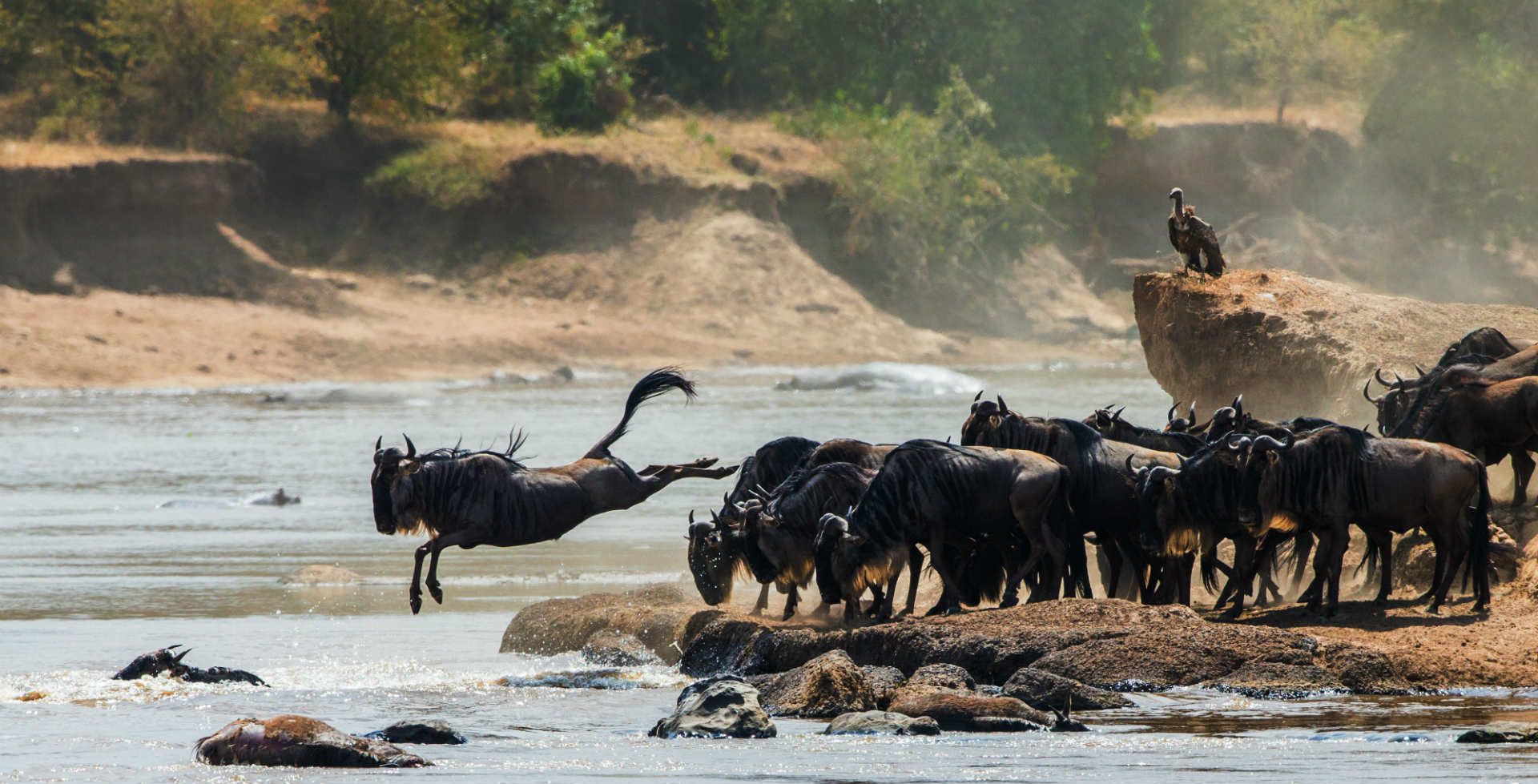
Wildebeest jumping into the Mara River during the Great Migration © Shutterstock
Why visit: mighty migrations and blissful beaches
Temperature: 59°F to 81°F (15°C to 27°C)
Average daily budget: $80-$120
Every May, an estimated 1.5-million wildebeest, and hundreds of thousands of zebras, antelope and topi begin the world’s largest animal migration.
From the plains of Tanzania’s southern Serengeti, to the grasslands of Kenya’s Masai Mara Game Reserve, one of the most spectacular moments of this epic 497 miles (800km) journey is the July river crossings.
As a result, wildlife watchers are drawn to the Mara River to witness swarms of wildebeest take on these crocodile-infested waters — the final obstacle of their voyage.
What's more, enjoying exhilarating safaris can be combined with visiting the coast, or Zanzibar, where out-of-this-world beaches await.
To make your experience all the more special, dive into our guide to the best time to visit Masai Mara, and read up on safaris in Kenya, and how to plan a Tanzanian safari.
Fancy blending wildlife-watching with time on the beach? Our Kenya itineraries provide exactly that.
Where to stay: Africa Safari Serengeti Ikoma offers spacious tents near the Serengeti's Ikoma Gate entrance.
Meanwhile, bird-lovers should take a look at Sekenani Camp Maasai Mara — gorgeous oasis of tented rooms surrounded by trees.
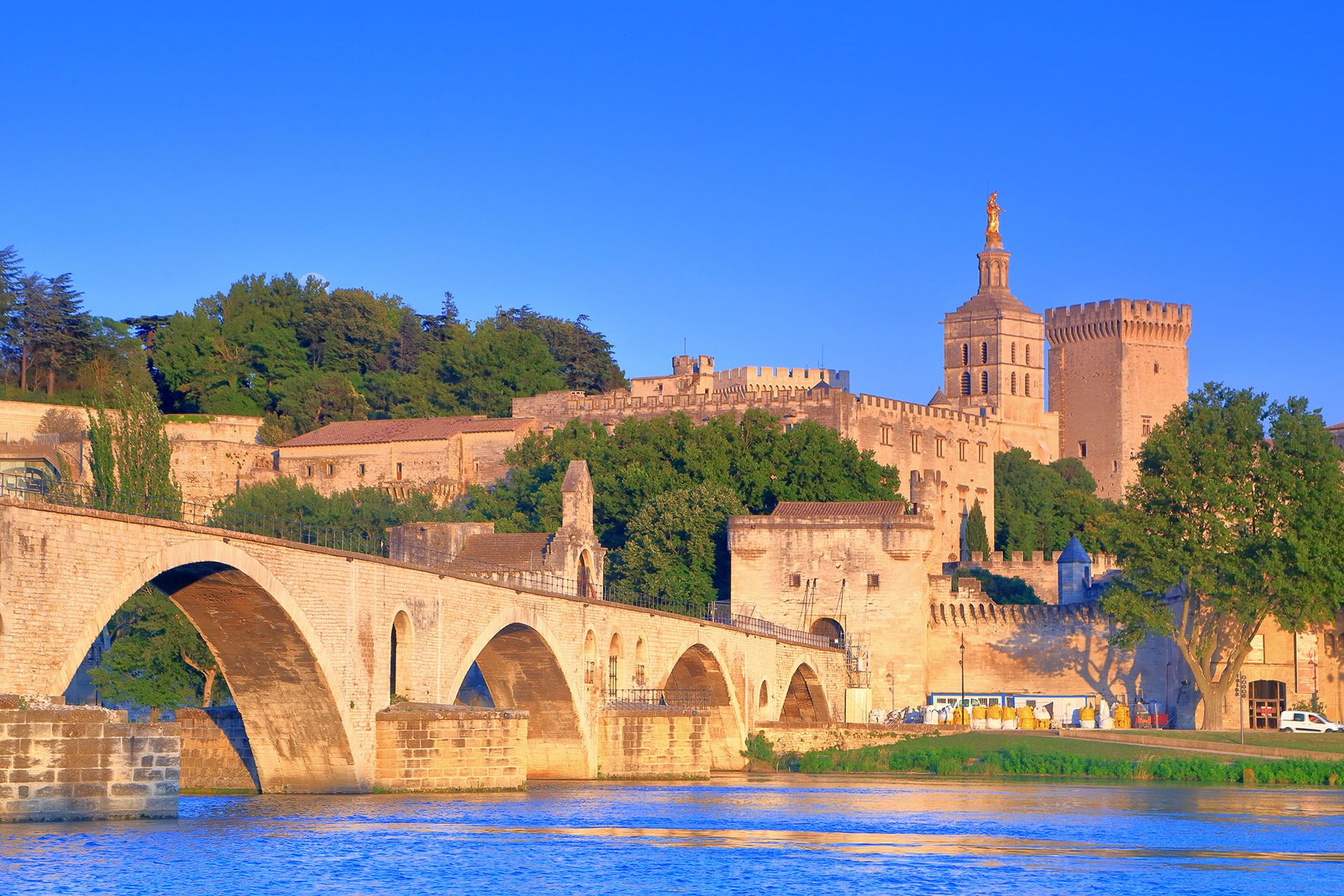
Cathedral and Papal Palace in Avignon, France © Shutterstock
Why visit: food, wine, UNESCO treasures and the Festival of Avignon
Temperature: 64.9°F to 88°F (18°C to 31°C)
Average daily budget: $200
Aside from visiting the Palais des Papes UNESCO World Heritage site — one of the most significant medieval Gothic buildings in Europe — and strolling along the Pont Saint-Bénézet bridge, visiting Avignon in July means you’ll get to experience the fabulous Festival of Avignon.
One of the largest and most prestigious arts festivals in the world, it sees the city transformed into a stunning stage for theater, dance, music, and visual arts performances.
In between all the shows, take time to savor Provençal cuisine at local restaurants and markets. July is the season for tomatoes, peppers, basil and thyme, which loom large in regional dishes like bouillabaisse.
Avignon is also an excellent base from which to explore the wine region of Châteauneuf-du-Pape. Take a short drive to visit vineyards, taste local wines, and enjoy scenic views of vine-covered landscapes.
Oh, and Avignon is also a great gateway to exploring the picturesque Provence region. For example, you could take day trips to the Luberon villages of Gordes and Roussillon, the lavender fields of Sault and Valensole, and the historic town of Arles.
Editor's tip: our France itineraries include Avignon
Where to stay: at once cosy and luxurious, Bastide de Bellegarde boasts an outdoor pool, great food and green grounds.
Meanwhile, La Divine Comédie-Suites Deluxe is also ultra-elegant, with luxutious rooms, glorious gardens and a pool.

Durdle Door on Dorset's Jurassic Coast © Patryk Kosmider/Shutterstock
Why visit: fossils, festivals, coastal adventures and clotted cream
Temperature: 60°F to 79°F (16°C to 26°C)
Average daily budget: $150-$200
Stretching from Exmouth in Devon to Studland Bay in Dorset, exploring the UNESCO World Heritage Jurassic Coast in July is a dream for dinosaur-mad kids, while all ages will adore seeing iconic landmarks like Durdle Door and Lulworth Cove.
The region also offers wonderful opportunities for outdoor activities, including hiking the South West Coast Path, cycling scenic countryside routes, and kayaking, paddleboarding and sailing the coastline.
If you’ve come for culture, head to picturesque Abbotsbury, with its swannery and sub-tropical gardens. Or how about Lyme Regis, which is known for its charming harbor, beaches, and Jane Austen connections.
While in said towns, be sure to enjoy divine Dorset fare, from locally sourced seafood and cream teas, to cider crafted from Dorset apples.
We also suggest spending time in Shaftesbury. With a steep incline snaking up thatched stone cottages that seem to be conjured from the pages of a fairy tale, Gold Hill is one of the most photogenic streets in the UK.
Where to stay: to stay in style in the heart of Shaftesbury, La Fleur de Lys has an award-winning restaurant.
Looking for somewhere in Lyme Regis? Featuring sea views, The Mariners Hotel — a former 17th-century coaching inn — is nestled in the heart of town and has a lovely large garden.

Rovinj, Croatia © Shutterstock
Why visit: blending city break culture with beach vacation bliss
Temperature: 68°F to 82°F (20°C to 28°C)
Average daily budget: $150-$200
Exuding an Italian vibe, romantic Rovinj is one of the best places to travel in July for those who want all the fine food and old town charm of a city break alongside beaches, boat trips and adventures on land and sea.
Located on Croatia’s Istria peninsula, Rovinj is very easy on the eye. Its charming Old Town is loaded with colorful buildings, galleries, boutiques and cafes, with the iconic hilltop Church of St. Euphemia offering panoramic views of the town and sea.
Talking of the sea, we recommend taking a boat trip to explore the beautiful islands of the Rovinj Archipelago, among them St. Catherine's Island (Otok Sveta Katarina) and Red Island (Otok Crveni Otok).
If you’ve come for the beach, be sure to check out Cuvi Beach and Mulini Beach, where you can swim and enjoy water sports, alongside simply stretching out on the sand.
When you’ve had your fill of chilling out, fill up on traditional Istrian cuisine in local konobas (taverns), where fresh seafood, truffle dishes, Istrian prosciutto (prsut), and local wines like Malvazija and Teran are likely to feature on menus.
Editor’s tip: like the sound of seeing Croatia’s captivating coastline from north to south? You’ll love our customizable 10-day Croatia itineraries.
Where to stay: for 5-star style and fine-dining Monte Mulini is surrounded by a centuries-old protected nature park and overlooks a beautiful bay.
Located in easy walking distance of Rovinj’s historic center and the seafront, Boutique Hotel Lili is bright and has a café-bar and summer terrace.
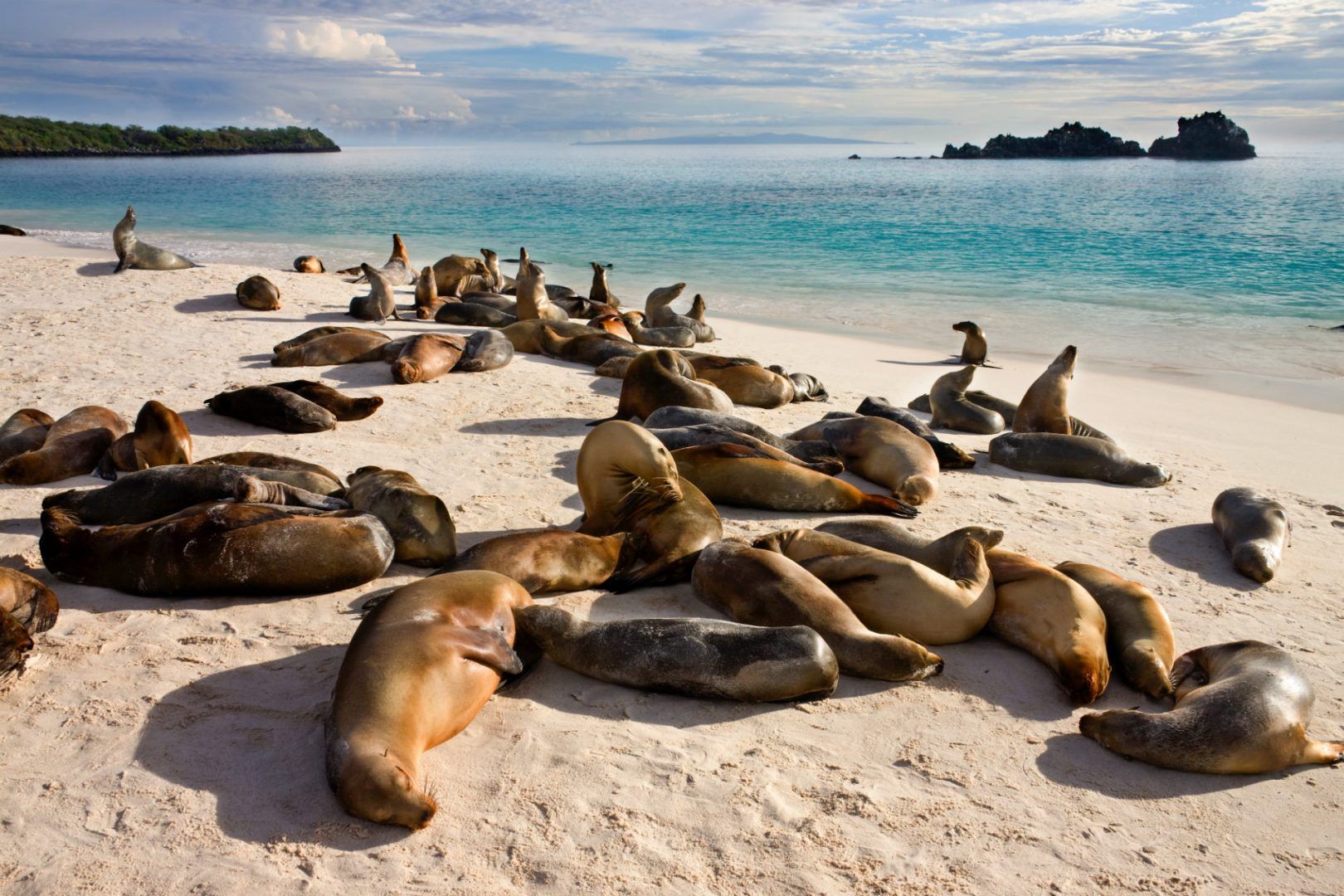
Sea lions, Gardner Bay, Espanola, the Galapagos Islands, Ecuador © Shutterstock
Why visit: unforgettable wildlife-watching in cooler conditions
Temperature: 70°F to 79°F (21°C to 26°C)
Average daily budget: $200-$250
Though the glorious Galapagos Islands are a year-round destination, if you visit in July you can expect the weather to be cooler and drier than the preceding months. It's also one of the best months to spot whale sharks on a diving trip.
Editor's tip: love underwater adventures? Check out our customizable Galapagos itinerary.
July also heralds the start of whale-watching season in the Galapagos, with trips to the Bolivar Channel between Isabela and Fernandina islands offering your best chance of seeing them.
In addition, July marks the start of sea lion breeding season, and it’s nesting season for the island’s iconic blue-footed boobies and waved albatrosses.
At the same time, you could see flightless cormorants courting and nesting — the extraordinary ritual is something you won’t forget anytime soon.
Into adventure? Our Ecuador itinerary will take you from Quito and Otavalo to the Amazon before moving to the Galapagos.
Where to stay: located on Pelican Bay, in the heart of Puerto Ayora, Santa Cruz, Hotel Solymar is minutes from the Charles Darwin station.
Hotel Acacia is another good Puerto Ayora option.

Otranto, Puglia © Shutterstock
Why visit: beaches, festivals and fine food
Temperature: 72°F to 86°F (22°C to 30°C)
Average daily budget: $150-$250
July is the perfect time for heat-loving sun-seekers to travel to impossibly pretty Puglia to make the most of the region’s many delights.
By which we mean beautiful beaches, charming historic towns, and lovely landscapes that offer opportunities to hike, bike, ride horses and cave around the heel of Italy’s boot.
If you’ve come for a beach vacation, Vieste is a popular vacation town, with lively nightlife during the summer high season. To avoid the crowds on the beaches closer to town, book a boat trip to the grotto-rich coastline around Testa del Gargano.
While in the region, we suggest visiting the Baroque town of Martina Franca, which hosts its annual Festival della Valle d’Itria from mid-July to early August.
Given that Puglia is known as the breadbasket of Italy, consider taking tasting tours of its sun-kissed olive groves and vineyards.
Lastly, when it comes to outdoor activities, take your pick from hiking Gargano National Park, exploring coastal caves, or cycling the countryside.
Editor's tip: Explore Puglia and Southern Italy with our Southern Italy itinerary.
Where to stay: surrounded by a beautiful green park, just outside Martina Franca, 5-star Villa San Martino is utterly elegant.
Visiting Vieste? Hotel Palme Gemelle is close to beaches, cycling routes and offers tons of on-site activities.

Knossos, Crete © Shutterstock
Why visit: beaches, culture and a feast of festivals
Temperature: 71°F to 90°F (22°C to 32°C)
Average daily budget: $150-$200
Hot and sunny, the weather in Crete in July is perfect for a classic Greek island beach vacation. Alongside summer serving lively parties on the island’s best beaches, July is also a great time to visit for cultural experiences.
From Rethymnon hosting a Renaissance festival and a wine festival, to the Lato Cultural Festival in Agios Nikolaos, there’s a festival for every taste.
On the subject of culture, you’ll most likely want to explore Crete’s ancient Minoan ruins archaeological museums, Venetian fortresses, and charming old towns like Chania and Rethymno.
And don’t forget that Crete also plays host to rugged mountains, picturesque hillside villages, and the incredible Samaria Gorge.
Editor’s tip: if you’re longing for awe-inspiring scenery, ancient culture, and a sense of freedom, our Crete itinerary have your name all over them.
Where to stay: located in Rethymno Town, SAVUS Boutique Hotel is close to the beach and old town.
Fancy staying in Chania? El Greco Hotel is located in the Old Town, next to the Venetian harbor and near Nea Chora beach. Also read our guide to the best areas to stay in Crete for more accommodation options.
Ready to explore Greece? Get started with our expert travel planning tips.
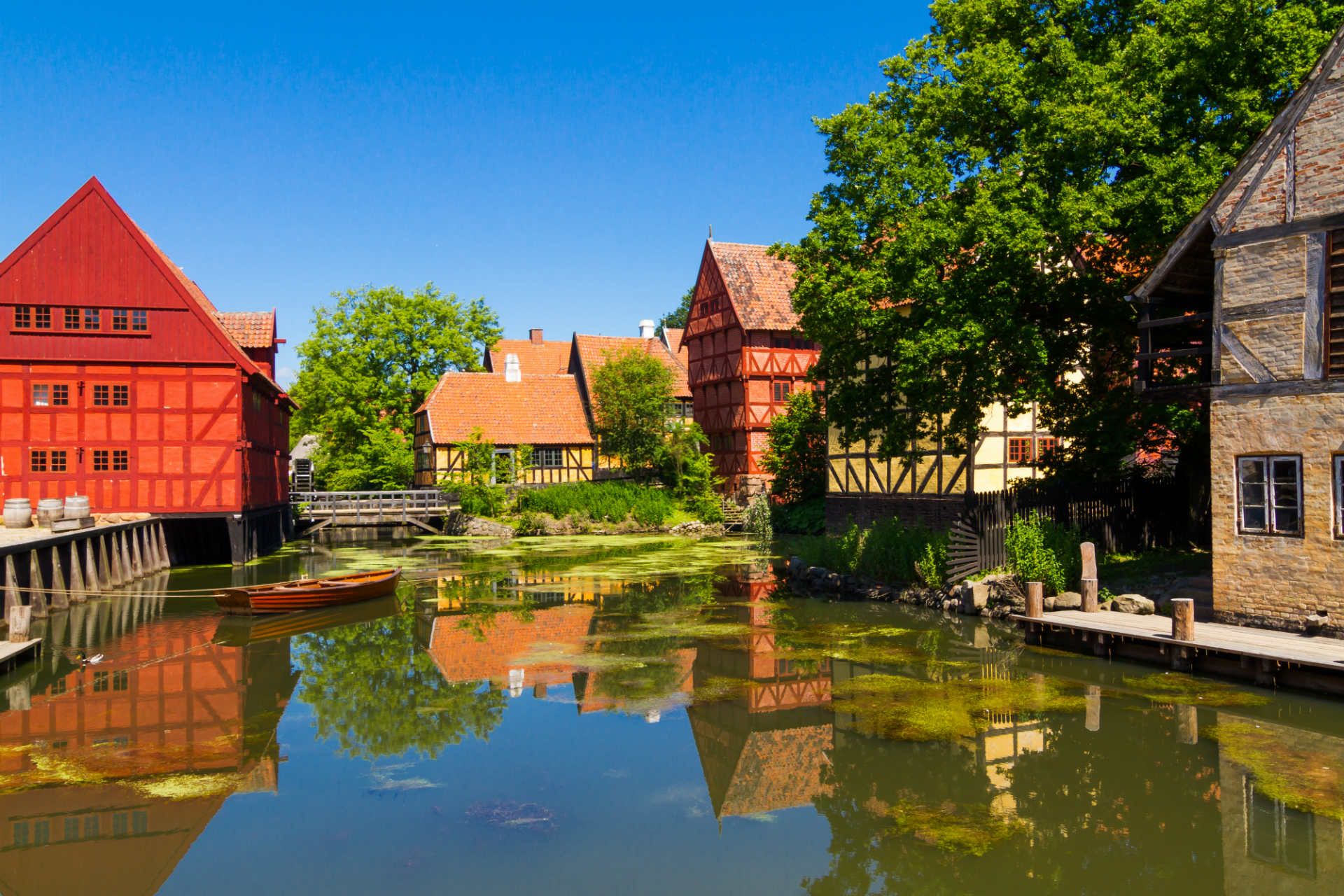
Aarhus, Denmark © Shutterstock
Why visit: warm days, cool culture, and a hip-and-happening jazz festival
Temperature: 59°F to 72°F (15°C to 22°C)
Average daily budget: $150-$250
Offering long, warm days, and welcoming vibe that leaves you longing to return, Aarhus, Denmark’s second city, is one of our favorite vacation destinations in July for tons of reasons.
Compact, with a glorious blend of old-town charm, stylish contemporary architecture, and green spaces, Aarhus is an utter joy to explore on foot, especially its quaint, café-loaded Latin Quarter (Latinerkvarteret).
For insights into Denmark’s past, visit the Den Gamle By open-air museum in the Old Town, and the Moesgaard Museum (just outside the city), the latter of which unveils Viking history.
Meanwhile, the ARoS Aarhus Art Museum showcases striking contemporary art collections and boasts the iconic Rainbow Panorama — a circular walkway that offers panoramic views of the city.
Aarhus also offers access to the joys of the Jutland peninsula. For walks and wildlife-spotting, head to Thy — Denmark’s first national park — or rugged Mols Bjerge National Park.
Also nearby is the Kattegat coast, with its windswept, white-sand beaches.
Back in town, the Aarhus Jazz Festival is held across the city, across eight days in mid-July.
Where to stay: set in an elegant neoclassical building, the 5-star Hotel Royal is a stunner. We also rate the charming SOFS Boutique Hotel in Aarhus's Latin Quarter.
Still haven't decided where to vacation this summer? Uncover the best places to travel in August
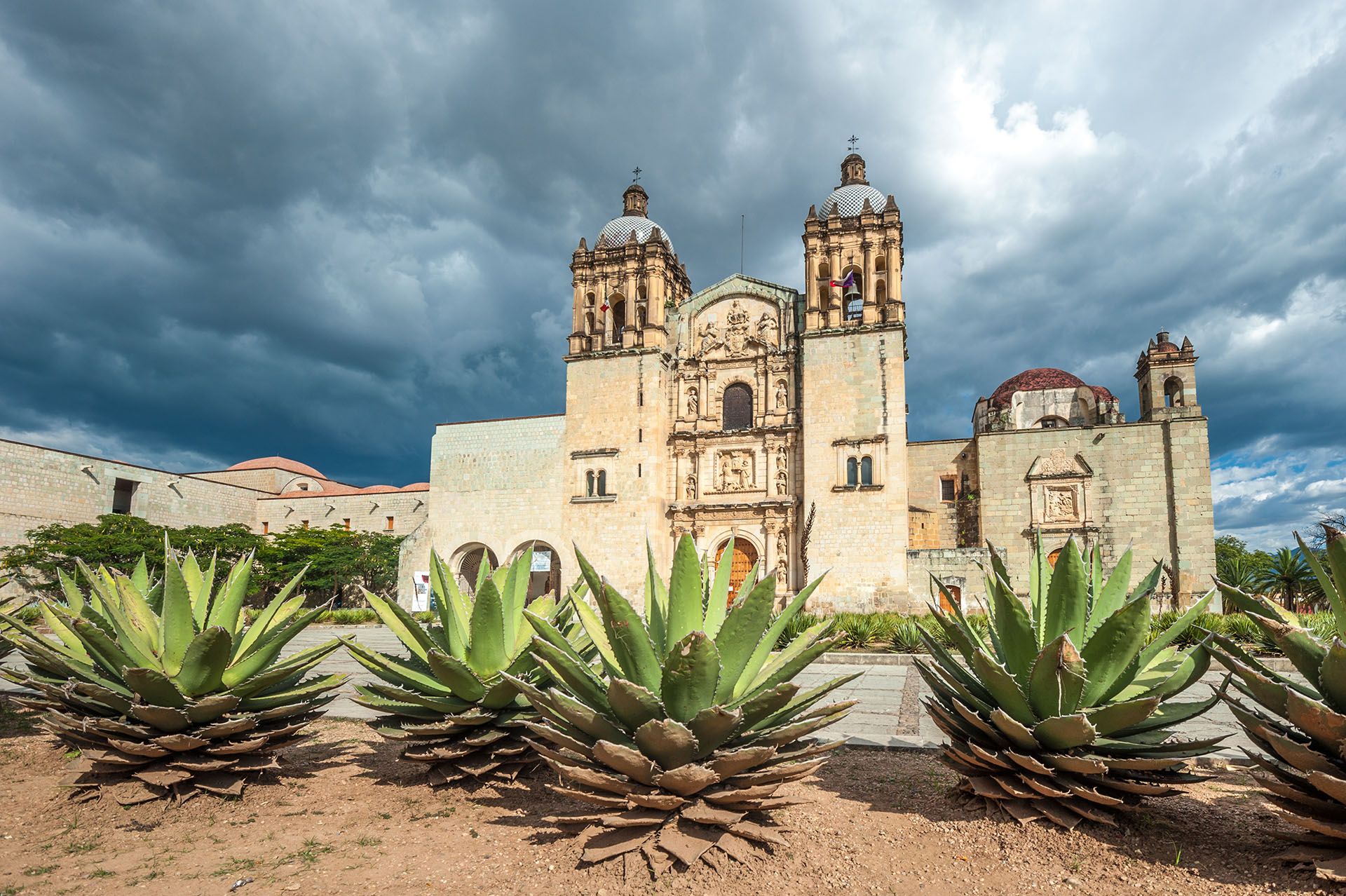
Church of Santo Domingo de Guzman in Oaxaca, Mexico © Shutterstock
Why visit: the Guelaguetza Festival, ancient wonders and Pacific Coast surfing
Temperature: 63°F to 81°F (17°C to 27°C)
Average daily budget: $80-$120
Hailed one of the best places in Mexico, Oaxaca city is known for its markets, craft stalls, Baroque architecture, and gallery-rich walkways.
Come late-July, the city hosts the dazzling Guelaguetza Festival — an event that celebrates the region’s ethnolinguistic groups through folk dancing, fairs, and concerts.
While in the area, you could also look to visit the Zapotec and Mixtec sites at Monte Albán, Yagul and Mitla. Though less known than their counterparts in central and eastern Mexico, they’re every bit as impressive.
Meanwhile, on the province's Pacific coast, Puerto Escondido attracts surfers, with lesser-visited beaches around Puerto Ángel boasting more of an alternative vibe.
Editor's tip: Explore Oaxaca and the rest of Mexico with our itineraries.
Where to stay: an oasis of calm in Oaxaca city, Hotel Escondido Oaxaca delivers 5-star style and service and has a rooftop pool.
For colorful traditional Mexican décor in a colonial-style building, try Parador San Miguel Hotel.
Still undecided abut where to vacation in July? You’ll find more ideas in our month-by-month guide to where to go when and our run-down of the best European summer destinations.
You might also want to make use of our tailor-made travel service.
written by
Joanne Owen
updated 03.04.2025
Joanne is a Pembrokeshire-born writer with a passion for the nature, cultures and histories of the Caribbean region, especially Dominica. Also passionate about inspiring a love of adventure in young people, she’s the author of several books for children and young adults, hosts international writing workshops, and has written articles on the Caribbean and inspirational community initiatives for Rough Guides. Follow her @JoanneOwen on Twitter and @joanneowenwrites on Instagram.
Use Rough Guides' trusted partners for great rates
Arrange your trip, hassle-free, with local travel experts
Arrange your trip with local travel experts